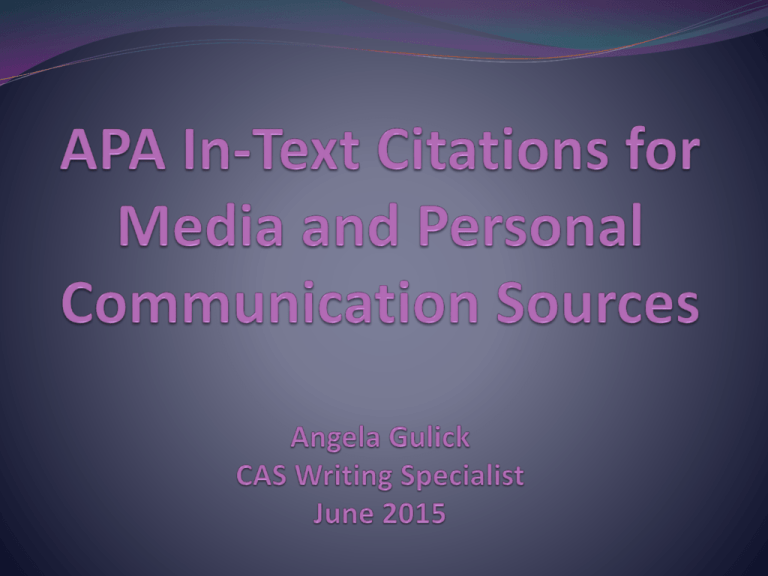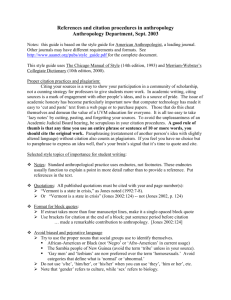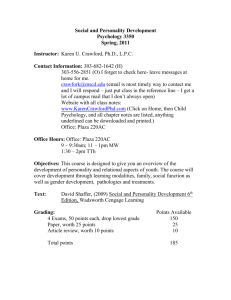APA In-Text Citations for Media and Personal
advertisement

The Definition of APA Documentation APA documentation is a system for you to tell readers that you are borrowing information from some outside written, personal communication, or media source. An outside source can be any of the following: written sources (print or electronic): books, magazines, newspapers, journals, pamphlets, handouts, website articles, and database articles personal communication sources: personal or telephone interviews, email messages, and personal letters media sources: films and television programs (both live and recorded), as well as music and other audio recordings The Definition and Benefits of Citations A citation is a place in your paper that tells readers where you got your information. A citation is the actual reference in your paper. Citing is the action of providing this information. Citations help you in three different ways: Citations give the original source credit for the information. Ethically, you can’t borrow another’s research, scientific findings, work, or ideas and pass them off as your own. You need to be very clear when you are reporting the words or ideas or findings of another source. Do you really want to take credit away from cute little kids like these?? Source for image: treehugger.com The Definition and Benefits of Citations Citations show that you’ve done your homework. If you went to the trouble of researching your topic and finding out what the “big names” in your topic have to say, show off! Cite those sources. They will add to the credibility of your writing. If you work this hard and you read this much, don’t you want a little bit of attention and credit? Source for image: unboundpotentials.com The Definition and Benefits of Citations Citations help readers find your sources on their own. Sometimes, readers want to find your sources to do further reading. Telling readers where you got your information, both in the paper and on a References list, gives readers a “treasure map” to finding those sources out in the real world. Source for image: starstore.com The Definition of a Signal Phrase In the olden days, court trumpeters would play a musical fanfare to alert the audience to the arrival of royalty. A signal phrase in writing does the same thing: it alerts the reader to the fact that you are announcing where you got your research. Source for image: marksbands.com The Definition of a Signal Phrase A signal phrase is a way to cite your source so that it is very clear to readers where your borrowing begins and where it ends. Here are some examples of signal phrases from interviews and email messages/personal letters: Jenkins writes……………………..…(personal communication, March 22, 2011). According to Jenkins………………(personal communication, March 22, 2011). When discussing common injuries of miniature poodles, Jenkins stated …………… (personal communication, March 22, 2011). Notice how the signal phrase shows where the source begins (Jenkins) and where the source ends (personal communication, March 22, 2011). This strategy makes it very easy for your readers to distinguish your own ideas from your sources’ ideas. Source for image: Angela Gulick and her poorly trimmed poodle Jasper Why We Recommend Using Signal Phrases The main benefit to a signal phrase is that it clearly establishes where your source begins and ends. For this reason, we recommend against putting the author, year, and page number at the very end of the source, such as this: …………………………………………………….(Jenkins, personal communication, March 22, 2011). Putting the (author, year, page number) information at the end of a source shows where the source ends, but it doesn’t show where the source begins. If you use the above strategy, you need to give your reader a clear indication as to where the source starts: As one veterinarian recently stated, …………………………….(Jenkins, personal communication, March 22, 2011). Sample Citations for Various Sources You can select a link below to get information on a particular type of source. To get back to this page, select the symbol next to the slide’s title. Citing Print and Electronic Sources Citing Personal Communications • Source with One to Five Authors •Personal or Telephone Interview • Source with Six or More Authors •Email Message or Personal Letter • Source with No Named Author • Two or More Sources by the Same Author in the Same Year • Person Quoted in Another Author’s Article Citing Media Sources •Television Program (Live and Recorded) •Film (Live and Recorded) •Music and Other Audio Recording Citing Personal Communications For personal communication sources, include the following details each time you use those sources throughout your paper: Name of person who was interviewed, wrote the email message, or wrote the personal letter Credentials of the person the first time the source is cited. Credentials are then omitted after the first citation. The words “personal communication” Date of communication Source for image: dipity.com Personal or Telephone Interview When documenting a personal or telephone interview, provide these details: Name of person being interviewed Credentials (such as job title or the number of years person has been involved with your topic) of person being interviewed the first time the source is cited. After that first citation, omit credentials. The words “personal communication” The date of the personal or telephone interview The first time you cite the interview: Carol Callahan, legal counsel for Piatt County, stated __________ (personal communication, November 10, 2007). Each additional time you cite the interview: Callahan also commented __________ (personal communication, November 10, 2007). Source for image: celebritique.com Source: emma-watson-pictures.blogspot.com Email Message or Personal Letter When documenting an email message or a personal letter, provide these details: Name of person writing the email message or personal letter Credentials (such as job title or the number of years the person has been involved in your topic) of person writing the message or letter the first time the source is cited. After that first citation, omit credentials. The words “personal communication” The date of the correspondence The first time you cite the email message or personal letter: Chris Henderson, a medical student at the University of Texas, wrote _____ (personal communication, May 19, 2009). Each additional time you cite the email message or personal letter: Henderson stated __________ (personal communication, May 19, 2009). Source for image: digitanis.com Citing Media Sources Because there are so many different forms of media, there isn’t one way to cite them. However, generally, you want to provide the following information: Provide the name of the creator or the character of the medium (often a director, a producer, an artist, a group, a narrator, a character in a work of fiction). Provide the title of the production, film, or recording. Provide the track or scene number of the information as well as the medium (CD, DVD, or Blu-Ray Disc. Provide the year of the form of media. Source for image: downloadwatchmoviesonlinefree.com Source for image: daemonsmovies.com Source for image: umgnashville.com Television Program (Live and Recorded) For television programs, provide enough details to give your reader the appropriate context for the cited material, such as the episode title, program title, and character or person speaking. If the television program aired live, provide the year and the word “television” at the end of the citation. If the television program was recorded, provide the year, format, and the scene number at the end of the citation (if available). On the program Hoarders, Dr. Harold Halverson, a psychiatrist specializing in compulsive-obsessive disorders, stated __________ (2010, television). In the episode “You Jump, I Jump” of the Gilmore Girls, Lorelai Gilmore stated __________ (2006, DVD, scene 3). Source for image: imdb.com Source for image: tvshowsdvd.blogspot.com Source for image: mytvblogandpodcast.blogspot.com Film (Live and Recorded) For films, provide enough details to give your reader the appropriate context for the cited material, such as the film title and character or person speaking. If the film aired live, provide the year and the word “film” at the end of the citation. If the film was recorded, provide the year, format, and the scene number at the end of the citation (if available). Nina Sayers, an extremely high-strung ballerina in Black Swan, claims __________ (2011, film). The character Daniel illustrates the devastating effects of grief in the movie Love, Actually when he states __________ (2004, Blu-ray, scene 4). Source for image: celebritywonder.com Source for image: daemonsmovies.com Music and Other Audio Recording For music and other audio recordings, provide enough details to give your reader the appropriate context for the cited material, such as the song/recording title and artist. At the end of the sentence, provide the year, medium, and track number (if available). Green Day, in the song, “Wake Me Up When September Ends,” sings __________ (2005, CD, track 5). Ricky Gervais, Steve Merchant, and Karl Pilkington discuss __________in “The Ricky Gervais Guide to the Arts” (2010, podcast). As Norah Jones sings in her song “Light as a Feather,” __________ (2010, MP3, track 11). According to David Sedaris, in his short story “SantaLand Diaries,” __________ (1999, audiobook). Note: If the recording was created by four or more people, provide the first listed creator’s name and the words “et al.” which stand for “and others.” Then provide the title of the work. End your sentence with (medium and year of release). What To Do if You Still Have Questions If you still have questions, please stop by the Writing Lab (D120). We are here to help. The librarians in the Parkland College Library are also here to provide assistance. Finally, please check out our list of writing workshops on the Writing Lab Portal Page. Thank you for your time today. Good luck with all of your writing projects.






